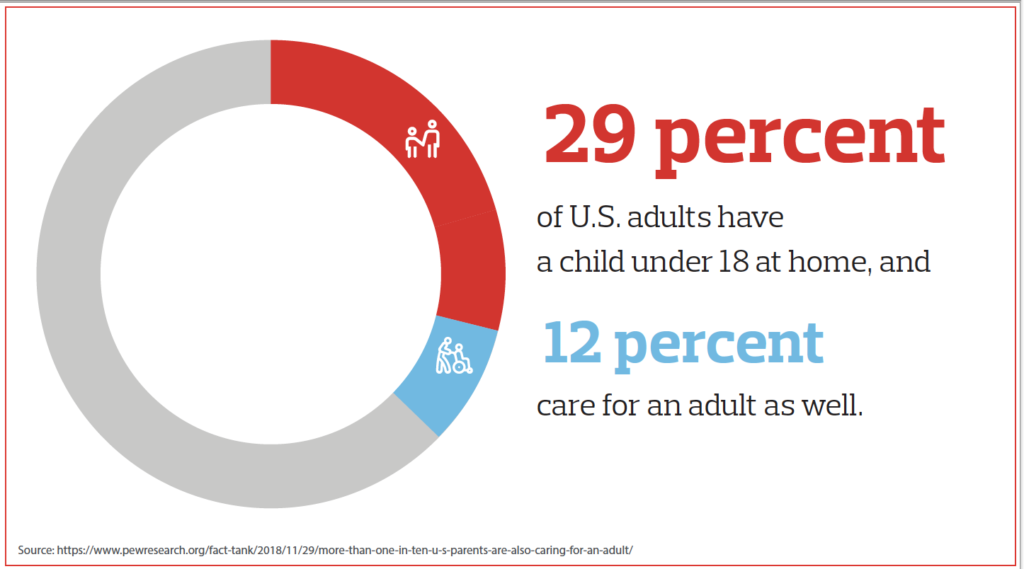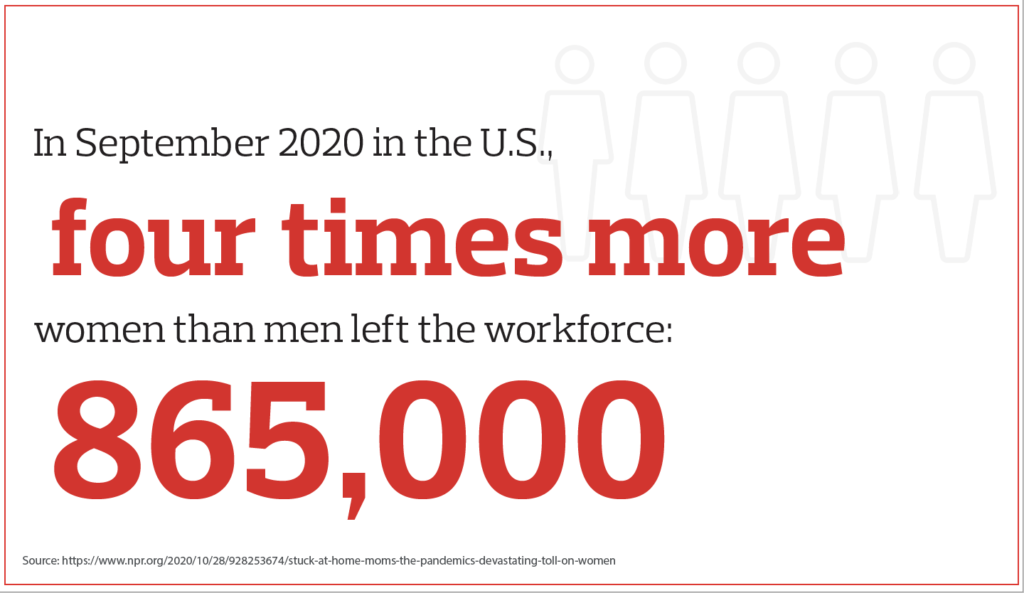April 7. 2021
Overview
For members of the generation juggling the dual responsibilities of children and older parents — the Sandwich Generation — balancing and prioritizing obligations was often a source of stress even before the COVID-19 pandemic. Now, the pandemic has ratcheted up the pressure.
According to the Pew Research Center, 29 percent of U.S. adults have a child under 18 at home, while 12 percent care for an adult as well. Those numbers will likely increase as the proportion of the population age 65 and over increases.

The impacts of the pressures facing the Sandwich Generation can make their way into the workplace in the forms of absenteeism, decreased productivity or increased turnover. And women are bearing the brunt. In September 2020 in the U.S., four times more women than men left the workforce: 865,000. It’s an issue employers need to be aware of and address, especially as the pandemic adds to the stress of Sandwich Generation employees.

“It’s important that employers understand the needs of these working parents and caregivers in the best of times — even more so as they are navigating the challenges of the pandemic,” says Julie Norville, senior vice president and Time Away Strategy leader at Aon. “Employers can create accommodations and resources that can help Sandwich Generation employees work together to meet their needs in these stressful times.”
In Depth
For Sandwich Generation employees, the COVID-19 pandemic heaped even more pressure on an already stressful life. Due to government lockdowns and social distancing efforts, many found themselves working remotely, some for the first time.
As they adjusted, many employees found themselves sharing a home with school-age children trying to practice remote learning. Thus, many employees took on a new role on top of their full-time jobs: teacher’s assistant.
“It’s definitely creating a problem for employees and for employers that are trying to figure out how to support employees with kids who are schooling from home in terms of balancing work and life,” Norville says.
Parents are also helping children navigate feelings of anxiety or other emotions stemming from the pandemic and their inability to interact with friends face to face.
Older Parents Need Help Too
Older loved ones, meanwhile, are among those at higher risk from COVID-19, often forcing Sandwich Generation members to look after their safety and worry about their wellbeing. That’s particularly true if an older loved one lives in a long-term care facility with higher virus risk.
Many older adults lack the technology savvy to order essential items like groceries online for home delivery, forcing their Sandwich Generation children to find solutions for day-to-day challenges. Recently, many members of this generation faced an additional source of stress in trying to help older parents secure COVID-19 vaccinations.
For some in the Sandwich Generation, the inability to visit older relatives because of social distancing to prevent the spread of COVID-19 can be a further source of stress.
Many of this generation’s workers are trying to deal with these new or heightened challenges related to their children and parents on top of full-time jobs.
In addition, grandparents or other older family members often served as backup childcare in pre-pandemic times. The need to reduce their potential exposure to the virus removed that childcare backstop for many employees, Norville says.
Understanding the Sandwich Generation’s Needs
For employers, there are a number of ways they can help Sandwich Generation employees address the added challenges of the pandemic. The first step is for business leaders to understand their employees’ specific needs.
“Employee surveys and focus groups are great places to start understanding what employees are facing and what they need,” says Norville. “From there, employers can design tailored solutions.”
Team leaders and line managers are also trusted resources. Employers can train their managers in ways they might help Sandwich Generation workers, or create tool kits or conversation guides that can help them recognize employees’ issues and needs.
Considering Flexible Work Options
An increasing number of employers are addressing the needs of the Sandwich Generation by offering flexibility in when, where and how work gets done. Beyond work at home, employers are offering relief to Sandwich Generation employees with flexible work options, such as flexible hours, compressed schedules and reduced schedules.
Flextime arrangements that give employees space in their day to meet the various demands they’re facing could go a long way to helping workers during the pandemic, says Norville.
“Requests for time away from work have increased. Employers aren’t sure how much time or what type of time should be allowed for employees to care for their children during the school day,” she says.
Flextime arrangements would allow employees to work outside their regularly scheduled hours to make up for time needed to help a child or care for an older loved one. It might mean working in the evening or working on the weekend to meet job requirements.
According to Norville, it’s important that employers formalize flextime policies to establish a sense of fairness in their treatment of different employees.
But for many employees, shifting hours isn’t enough to assist them with juggling the increasing responsibilities they have faced during the pandemic. Part-time work policies are a tool many employers are using to provide some relief from the stress and strain of day-to-day life, including employees who wouldn’t have considered them pre-pandemic.
“Part-time options are a good retention tool to avoid losing employees — especially women — due to these challenges,” says Carol Sladek, Work-Life Consulting practice leader at Aon.
Similarly, Sladek says some employers are offering job-sharing arrangements — allowing two employees to work part time to share one job — to help employees with pandemic pressures. And others offer phased leave programs — allowing employees to take time off and return on a part-time schedule for some period of time.
Sladek says the idea of a four-day compressed workweek is another flexible work arrangement some employers are considering as they respond to the needs of their working-parent and caregiving employees. The governments in Spain and Japan announced plans to explore a four-day workweek option with the goal of improving wellbeing and productivity.
Learning Pods and Other Creative Solutions
Norville says employers are also making remote education easier for employees’ children by helping them form “learning pods,” where small groups of students can learn together at home with tutors or parents sharing teaching duties.
Companies with a smaller concentration of workers could collaborate with other businesses to provide such resources to employees.
Job-sharing arrangements or even retiree rehiring programs can also be useful tools to help reduce the time demands on pandemic-stressed Sandwich Generation workers, says Norville.
Employers also can create employee resource groups and social networks that allow workers to support one another and share solutions as they navigate these challenges.
Why Helping the Sandwich Generation Will Benefit Employers
Employers that find ways to help their Sandwich Generation employees deal with the added stresses of the pandemic can benefit through improved productivity and better retention of valued workers who otherwise might be forced to leave to handle family issues.
“Working with each employee individually is critical to the success of these arrangements,” Norville says. “Finding ways to support Sandwich Generation workers through added pandemic challenges can help get them through it. It can also help them remain valued employees at a time the business is facing its own pandemic challenges.”
The post Coping With COVID: The Impact on Sandwich Generation Workers appeared first on The One Brief.
